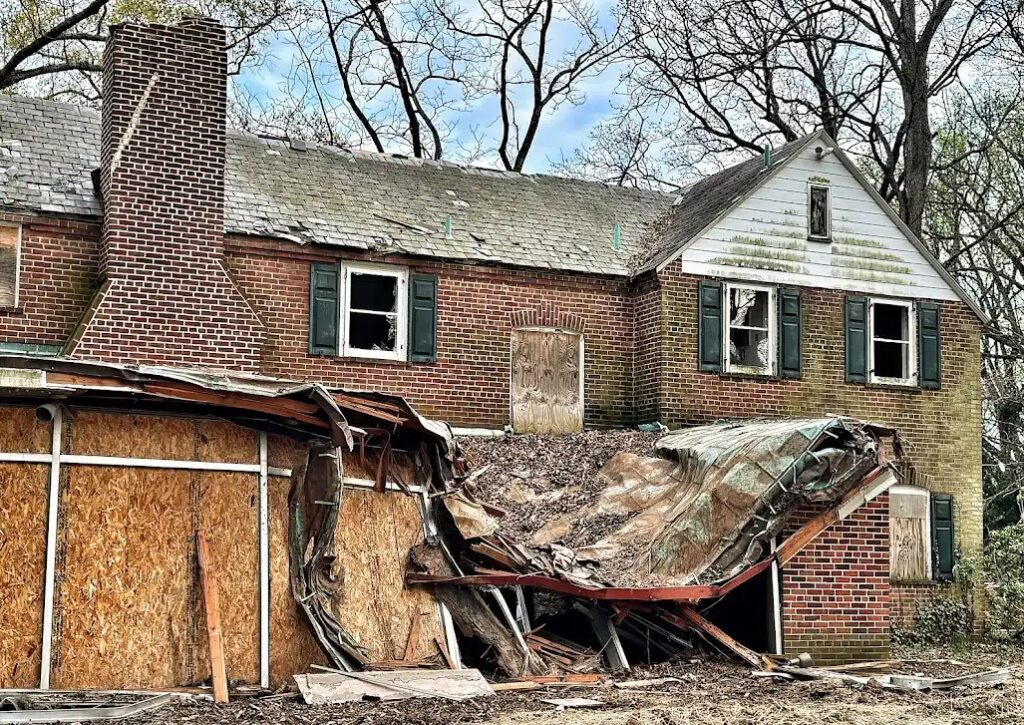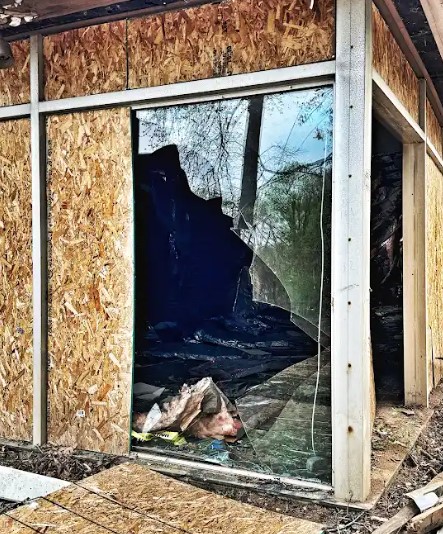White Gardens show signs of neglect

Over a year ago, the Fairfax County Park Authority dropped plans for a Resident Curator to maintain the John C. and Margaret K. White Gardens and agreed to preserve and enhance the park’s natural and horticultural resources.
The White Gardens are a hidden oasis in the midst of the Falls Church area of Mason District.
At a public meeting in February 2023, the Park Authority announced plans to tear down the White family’s former house and restore the property as a community park – in accordance with the wishes of the descendants of Margaret and John White. Community members overwhelmingly opposed having the park overseen by a resident curator living in the house.

The house is still standing, although it’s falling apart. The meadow is being taken over by weeds. The fence is falling down. And the rhododendrons and camelias that had been lovingly cultivated by the Whites appear neglected.
A large oak tree fell on the house during a windstorm, causing a partial collapse of the roof and the glass-enclosed patio. As a result, large shards of broken glass pose a hazard for park visitors.
A park bond passed in 2012 allocated $500,000 for the White Gardens – without a whole lot to show for it. Park Authority spokesperson Ben Boxer, however, said a lot of work has been done at the park over the years.
Boxer said the bond funds were spent on archaeological and historical reports, restoration of the meadow, the removal of invasive weeds, horticultural planning, phased plant installation, decorative wood fencing, the installation of stone along the driveway, ADA-compliant parking, and pavement and drainage improvements.
Some of the bond funds were also used for improvements to the house and barn to prepare for the resident curator program – before the decision was made to demolish the house.
Related story: Park Authority drops plans for a resident curator at the White Gardens
“The use of the bond funds served as important investments in sustaining the property and ultimately its protection as a natural resource park,” Boxer said. “It is a special park and over the last year we invested quite a bit of time and resources to improve it in the long-term.”
“This includes working through the extensive permitting process to demolish the house, which will begin in mid-May,” he said.
The Park Authority’s immediate plans for the park call for fixing the fence and boarding up what’s left of the sunroom.
According to Boxer, the temporarily unsightly brown-gray hanging vines “reflect the treatment of various invasive woody plants across the entirety of the park by our Natural Resources Team that occurred from December 2023 to March 2024.”
The Park Authority’s contractor double-cut most of the invasive vines that were competing with native trees, dramatically changing the appearance of the wooded area around the meadow, he said .

Last fall, Park Authority ecologists removed invasive plants within the meadow and repaired fencing to keep deer away from native species. The meadow will be mowed this spring to suppress invasive plants and promote regeneration of native species.
The horticulture team at Green Spring Gardens, along with volunteers removed invasive vines and other weeds from the newly planted areas and carried out general cleanup around the paths, Boxer said. Large quantities of invasive garlic mustard and porcelain berry were removed.
Margaret White had deeded the property to Fairfax County in 1999, rather than sell it to a developer, because she wanted to preserve the rhododendrons, azaleas, and camellias for the public’s enjoyment.


It’s a disgrace. The amount of work needed not only for the house but the grounds is in the tens of millions. Fairfax County executives should be ashamed. I for one would like to see an audit to figure out how this happened so it never happens again.
Can someone please explain to me why a derelict, eyesore of a house that belongs to the county and sits on property also belonging to the county must go through an “extensive permitting process” by the county before it can be demolished? For sure, before I vote for the next park bond, I intend to find out exactly what it will be used for. Best I can tell from this article, much of the 2012 bond for this property, was wasted in studies and improvements to a house that’s no longer needed, and, I can’t help but point out, bond funds were also used to probably construct a couple of curb cuts, paint some white lines and stencil handicapped symbols for the “ADA-compliant” parking lot.
I’m sure that Park Authority staff do a good job in many areas, but it’s been my experience that they’ve been fairly unresponsive to concerns that have been raised about issues in my neighborhood, and in general, appear to follow their own drumbeat rather than respond to the needs, desires of the community.
It appears that the demolition permit process is fairly straightforward per http://www.fairfaxcounty.gov/landdevelopment/permit-library/demo-residential
There are a number of steps and requirements, but they seem reasonable (like making sure utilities are disconnected via a disconnect letter and that any asbestos is abated). Getting funding for the demolition is probably the hardest part, but it seems like the house would be condemned and priority made to take it down. And it’s budget time so getting it paid for should be easier.
The park authority likes to spend time on studies and reports — all to no avail and no substance all the while collecting taxpayers’ money, retirement funds, and health care subsidies. It is a disgrace.
lookin like a trap house
Over twenty years – very SAD
What is the plan for the park after the house demolished? Will it remain parkland?
You should ask the head of the park authority, Jai Cole.
Thank you, Annandale Today, for keeping White Gardens visible.
It has become a lost park: is not indexed for finding on the park authority website, has no exterior signage, has no welcome mat put out for the public, dormant master plan over a decade old, and no commitment forthcoming on how to move forward. It is simply a place you might stumble upon if you were wandering about lost in the immediate vicinity.
Here are two other comparably special sites, in our north county area, with which nothing has been done.
1/ Lahey Lost Valley Park, Vienna
Carlotta Lahey, widow of artist and Principal of Corcoran School of Art Richard Lahey, donated her property to the park authority in 1990, and the transfer completed upon her death in 1999.
Lahey Lost Valley is 22 acres, one mile from Meadowlark Botanical Gardens, two miles from Wolf Trap National Park for the Performing Arts, close to the W&OD trail. As you enter you proceed through a stunningly beautiful streamside clearing surrounded by woods. The 2002 master plan (found online under park authority master plan archives) describes an art-focus public park, with meeting space for art groups, the free standing cottage in use for classes or an artist’s studio, where Mrs Lahey’s art collection (she donated all the property ‘s antiques and art) could be displayed, partnerships with local arts schools, and detailed descriptions of the proposed entryway, the restrooms, the parking, the stream side trail, etc.
2/ Gabrielson Gardens, Oakton
This was the home of Ira Gabrielson (1889-1977), about whom a historic marker reads:
“Oakton resident Dr. Ira Noel Gabrielson was a pioneer conservationist, distinguished field ornithologist, and renowned author. He served as the first director of the U.S. Fish and Wildlife Service and an international leader of conservation projects. Gabrielson was a founder and the first chairman of the Northern Virginia Regional Park Authority and first president of World Wildlife Fund-US. For his life’s work, he was inducted into the National Wildlife Federation’s Conservation Hall of Fame in 1978. His land, between Leeds Road and Difficult Run, is a Fairfax County park known as Gabrielson Gardens Park.”
He designed his gardens and wetlands to be a bird and waterfowl sanctuary, and to showcase plantings.
There’s no published master plan, so one does not know the intended purpose of the park. He has been gone 47 years now. There must be some way to develop the park to shine light on his life work, on the international and local conservation movement, on the parks movement, on local flora and fauna. There must be collections of papers somewhere that would make a fantastic research project for a local student, or an entire class.
White Gardens, Lahey Lost Valley, Gabrielson Gardens, and others, need help to succeed. We need partnership mechanisms to allow nonprofit groups in who can turn them into the public asset promised.
Also needed:
Master plans with implementation dates, for accountability.
An online index to bond funds committed and spent at every park site, for accountability.
A new policy on acquisitions, perhaps: don’t take on what we can’t manage, encourage potential donors to put conservation easements or other covenants on their land instead of transferring ownership to the county.
Keep our park acquisitions visible!
My name is Larry Oppenheimer. I am a member of the Friends of Holmes Run, however these comments are my own, and have not been reviewed by the FofHR.
I have been walking the White Gardens with my dogs about once a week for several months. I’m very interested because my family’s hobby when I was young was to rescue properties and convert them into state parks in Pennsylvania. I spent a lot of time maintaining gardens similar to the White Gardens.
I would like to meet you and walk the Garden with you so I could get your priorities for next steps. Please respond.